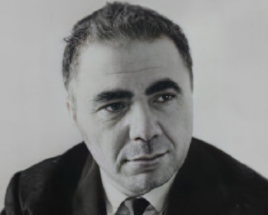Viktor Hambartsumian
Thursday, September 18, 2025
Viktor Amazaspovich Ambartsumian (Russian: Виктор Амазаспович Амбарцумян; Armenian: Վիկտոր Համազասպի Համբարձումյան, Viktor Hamazaspi Hambardzumyan; 18 September [O.S. 5 September] 1908 – 12 August 1996) was a Soviet and Armenian astrophysicist and science administrator. One of the 20th century's leading astronomers, he is widely regarded as the founder of theoretical astrophysics in the Soviet Union.
Educated at Leningrad State University (LSU) and the Pulkovo Observatory, Ambartsumian taught at LSU and founded the Soviet Union's first department of astrophysics there in 1934. He subsequently moved to Soviet Armenia, where he founded the Byurakan Observatory in 1946. It became his institutional base for the decades to come and a major center of astronomical research. He also co-founded the Armenian Academy of Sciences and led it for almost half a century—the entire post-war period. One commentator noted that "science in Armenia was synonymous with the name Ambartsumian." In 1965 Ambartsumian founded the journal Astrofizika and served as its editor for over 20 years.
Ambartsumian began retiring from the various positions he held only from the age of 80. He died at his house in Byurakan and was buried on the grounds of the observatory. He was awarded the title of National Hero of Armenia in 1994.
Ambartsumian was born in Tiflis on 18 September [O.S. 5 September] 1908, to Armenian parents Hripsime Khakhanian (1885–1972) and Hamazasp Hambardzumyan (1880–1966).Hripsime's father was an Armenian Apostolic priest from Tskhinvali, while Hamazasp hailed from Vardenis (Basargechar) His ancestors had moved from Diyadin, what is now Turkey, to the southern shores of Lake Sevan in 1830, in the aftermath of the Russo-Turkish War. Hamazasp was an educated man of letters who studied law at Saint Petersburg University. He was also a writer and translator and notably translated Homer's Iliad into Armenian from Classical Greek. In 1912 he co-founded the Caucasian Society of Armenian Writers, which lasted until 1921. Ambartsumian was the secretary, while Hovhannes Tumanyan, the famed poet, served as its president.Ambartsumian knew Tumanyan personally. In 1922, after the 14-year-old boy described Sirius to him, Tumanyan wrote a short poem about the star.
Ambartsumian's parents married in 1904.He had a brother, Levon, and sister, Gohar. Levon, a geophysics student, died at 23-24 while on an expedition in the Urals.Gohar (1907–1979) was a mathematician and Chair of Probability Theory and Mathematical Statistics at Yerevan State University towards the end of her life.
Ambartsumian developed an early interest in mathematics and was able to multiply by the age of 4. His interest in astronomy began with reading a Russian translation of a book by Ormsby M. Mitchel at 11. By his own account, he considered himself an astronomer by the age of 12.Between 1917 and 1924 he studied at Tiflis gymnasiums #3 and #4 where schooling was done in both Russian and Armenian. In 1921 he transferred to gymnasium #4 to study under Nikolay Ignatievich Sudakov, a Moscow-educated astronomer, whom Ambartsumian called a "very serious teacher of astronomy." Ambartsumian worked with Sudakov at the school observatory the latter had built. At school, Ambartsumian wrote several papers on astronomyand delivered lectures on the origin of the Solar System and extraterrestrial life at "first in school and then in the various clubs and houses of culture" beginning at 12–13. In 1924 Ambartsumian delivered a lecture at Yerevan State University about the theory of relativity. He also met Ashot Hovhannisyan and Alexander Miasnikian, Armenia's communist leaders.
In 1924 Ambartsumian moved to Leningrad, where he began attending the Herzen Pedagogical Institute. Shakhbazyan suggests that his non-peasant, non-proletarian background prevented him from entering Leningrad State University (LSU). However, Ambartsumian explained in an interview that by the time he arrived in August, LSU's admissions were already closed. To avoid losing a year, he opted to study in the physics and mathematics department of the pedagogical institute. After one year, he transferred to LSU's physics and mathematics department. At university, Ambartsumian was interested in both astronomy and mathematics. "I loved mathematics, but at the same time I felt that my profession would be astronomy. Mathematics was like a hobby, but I did complete the full mathematics curriculum. Thus you could say that I graduated with a major in mathematics, but in fact it is recorded that I graduated as an astronomer," he said in an interview in 1987. At LSU among his professors were the physicist Orest Khvolson and mathematician Vladimir Smirnov. He studied alongside other major Soviet scientists such as Lev Landau, Sergei Sobolev, Sergey Khristianovich and George Gamow. In 1926 he published the first of his 16 scholarly papers as a student. He graduated in 1928, although he received his diploma only fifty years later—in 1978. His undergraduate thesis was "devoted to a study of radiative transfer radiative equilibrium."He completed his postgraduate studies at the Pulkovo Observatory under Aristarkh Belopolsky between 1928 and 1931





